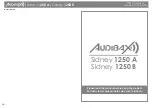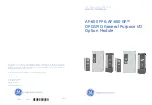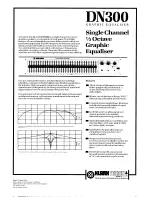
1
10
Sidney
1250 A /
Sidney
1250 B
USER´S
MANUAL
MANUAL
DE USUARIO
Safety and environment protection
1. To avoid electric shock risk, do not open the box. No accessories can be change in the
box.
2. Before the using, make sure the National standard voltage match the receiver. For long
time no using, please move out the power plug from the power outlet.
3. In order to fully ventilation, the hold set system should keep minimum
30CM from other things. Bad ventilation environment will result the system getting hot and
damage or even result in fire. Newspaper. dishcloth. curtain and other things should move
out from the hold set system for fully ventilation.
Do not put some blaze headstream on the system such as the candle.
Keep away the whole set system from the dusty. wet or the direct sunlight place.
Move out the liquid from the system to escape getting electric shock.
Do not put it in a mechanical shock and vulnerable place to avoid damage, and do not
knock and huff the microphone head
4. In order to obtain good results, as far as possible keep away from the high-voltage
transmission valve, large metal objects, as well as computers, high-power interphone, radar
and other equipment.
5. Please use the professional alkaline battery or rechargeable battery, fix up the batteries in
the right direction, turn off the transmitter after the use to save the power, and for long time
no use, remember to move out the batteries.
6. For long time no use, move out the power adapter from the outlet.
7. Throw the scrap batteries into the specifically place.
Brief introduction of the performance
These series products adopt UHF frequency and use the international standard common
frequency which can be used in all over the world. Due to the low frequency and many
reasons, traditional wireless microphone usually disturbed by many factors especially by the
variety of harmonic which send off by the CD/CD/LD and other digital equipment. Squelch
circuit usually analysis the intensity of the RF frequency channel instead of the noise and the
needed signal. Using the low traditional wireless microphone in the complex environment or
when the signal of the microphone is weak or the microphone is closured, the squelch circuit
may suddenly open which result the receiver send out a strong burst of noise
Do not change the frequency when using one set system.
Using more than one set system at the same time, make sure the transmitter and the receiver
of each system have the same frequency channel.
Using many transmitters or receivers in the same time, choosing the best frequency channel
is recommended.
Main performances
1. UHF 500-900 MHz, avoid the disturb frequency.
2. Adopts multilevel and narrowband high and mid frequency technology, the system can
search the best channel and eliminate the disturbing signal.
3. Thick undertone, light mediant and clear alt.
4. ALC circuit, avoid sound distortion by large sound.
5. Low power consumption components, long battery life.
6. Shield antenna for the handheld microphone, practical and beautiful.
7. Low power indicator for the handheld microphone, indicate change the battery in time.
8. With audio compressing-expanding technology, the system can avoid noise and increase
the dynamic range.
Especificación de la tecnología del receptor
1. Modo de recepción:
Conversión doble superheterodina
2. Sensibilidad: -93dBm
3. Salida de audio:
Salida de balance XLR: 0~500mV
Salida de desequilibrio Ф6.35: 0~500mV
4. Potencia: 220V/50Hz o 110V/60Hz
5. Potencia nominal: 5 W
6. Consumo de energía nominal: 3W
Solución de problemas
La información de este manual está sujeta a cambios sin previo aviso. Este manual contiene toda la
información sobre el producto, cualquier cosa que no sea clara o sea falsa o se pierda, contáctenos y solicite
información. Sin la confirmación, no podemos aceptar ninguna responsabilidad por cualquier pérdida o daño
causado por el servicio, mantenimiento o reparación por parte de personal no autorizado.
Fenómeno
Razones
Solución
Indicador sin luz
Configuración de la batería en
polaridad invertida direccional
Restablezca la batería en la
dirección de polaridad correcta
Falta de poder
Cambiar la batería de potencia
completa
El clip conectado de la batería
está sucio o se ha corroído
Limpie o cambie el clip del pin
de conexión
Indicador centelleo durante el
uso
Falta de poder
Cambiar la batería de potencia
completa
La ventana VDF del receptor se
apaga
No conectar la electricidad
Compruebe el adaptador de
alimentación de CA y el voltaje
La alimentación del receptor no
está bien conectada
Compruebe si el adaptador de
alimentación de CC está
insertado un extremo en la toma
de corriente, mientras que el otro
extremo está insertado en el
receptor.
El receptor no tiene recepción
Sin girar el micrófono
Encienda el micrófono de
trabajo
La frecuencia del micrófono no
coincide con el receptor.
Usar el mismo sistema de
frecuencia
El micrófono excede la distancia
de trabajo
Volver a la distancia de trabajo
El receptor recibe recepción
pero no hay sonido
El volumen debe estar en el nivel
más bajo
Ajustar el volumen del transmisor
y del amplificador
Conexión mala o incorrecta con
la línea de audio
Conecte la línea de audio de la
manera correcta
El receptor tiene recepción antes
de encender el micrófono, algo
de ruido en la caja de
resonancia
Algún equipo de la misma
frecuencia aparece en el rango
de trabajo
Cambie el lugar de trabajo para
evitar la interrupción, mantenga
cierta distancia con la
computadora, el teléfono móvil
que funciona
Caja de sonido enviar sonido
Comentario
Baje el volumen, no apunte el
micrófono directamente a la
caja de sonido
El sonido no es consecutivo.
Superar la distancia efectiva
Volver a la distancia de trabajo
Distancia de trabajo demasiado
corta
El entorno es demasiado
complejo.
Evite el entorno complejo y,
posiblemente, para evitar el gran
tema de metal, la pared, la
multitud
























